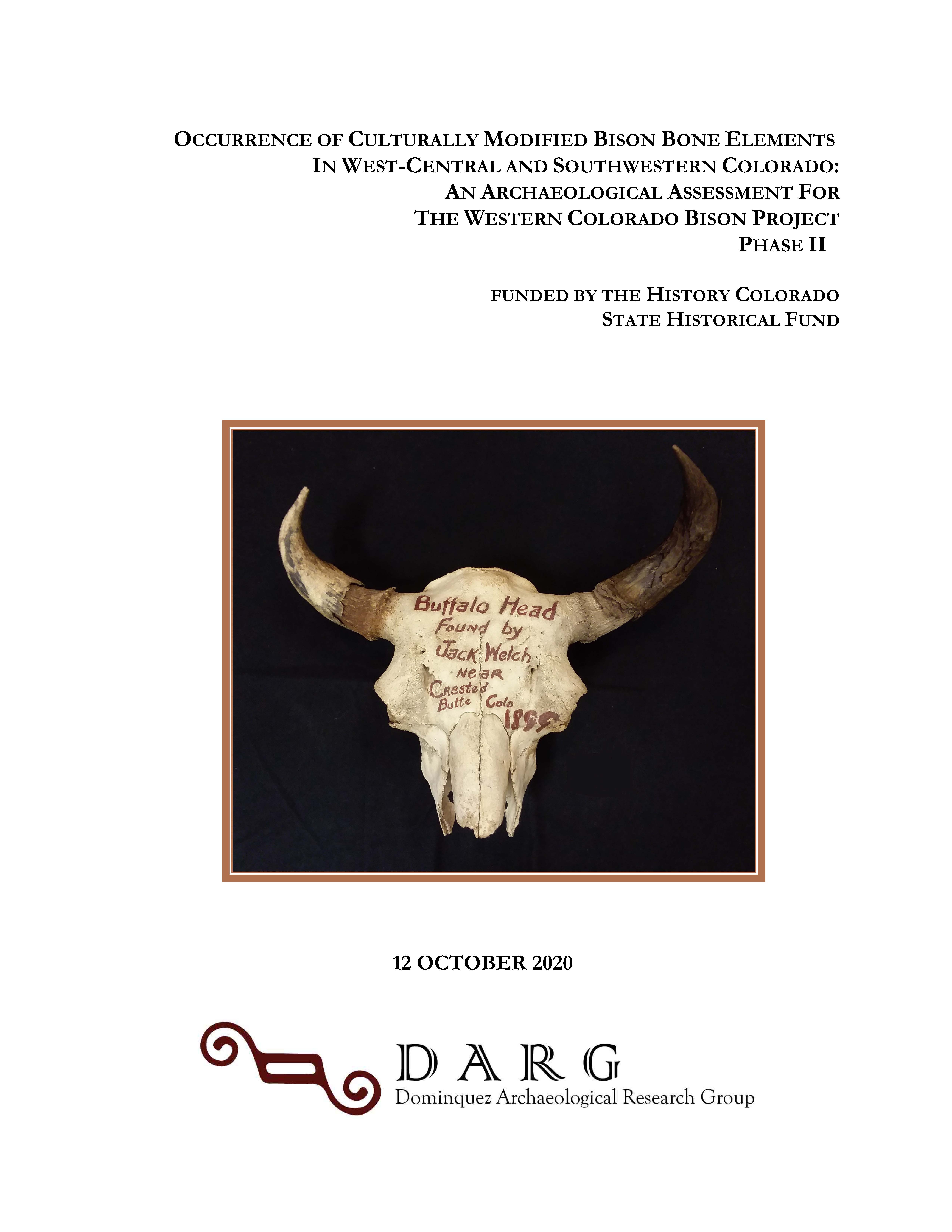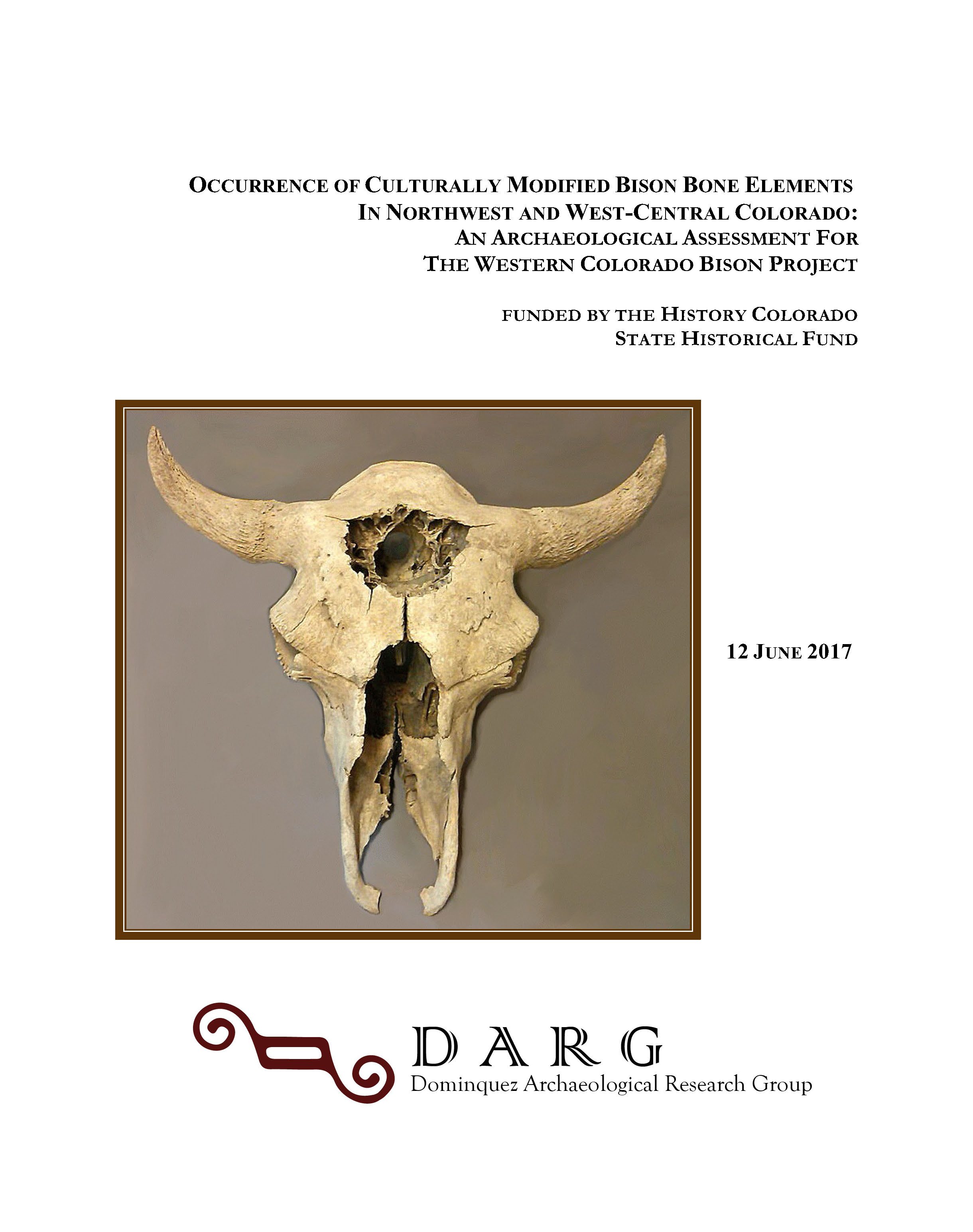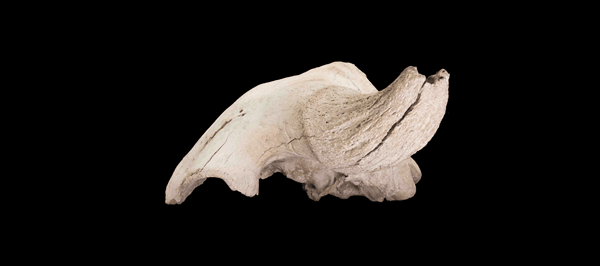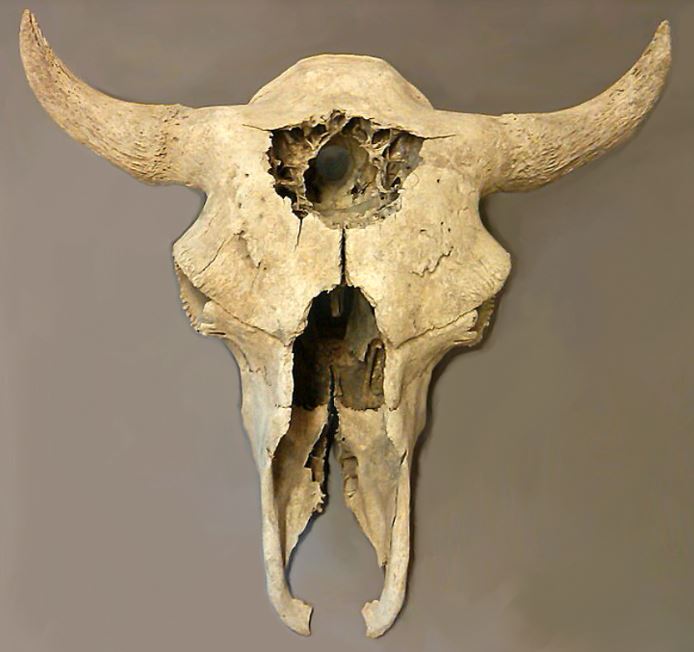
Bison Studies
Project Summary
Evidence of bison and aboriginal bison procurement in western and northwestern Colorado is extremely rare as is scientific documentation, examination, and radiometric dating of culturally modified bison bone elements, thereby making it nearly impossible to provide valid interpretations of the interrelationship of bison and prehistoric peoples in western and northwestern Colorado. To date no known research projects specifically dedicated to evaluating, dating, and assimilating the resultant data of known culturally modified bison faunal elements have been done in this region of the state.
Some present day historians and researchers are of the opinion that harvestable bison populations on the western slope of Colorado were unsustainable and that the majority of bison bone previously noted or recovered was likely obtained from the Great Plains of eastern and southeastern Colorado or are remnants of modern private herds. However; research by Butler; and Meaney and Van Vuren confirm the occurrence of bison west of the Great Plains. Meaney and Van Vuren compiled record searches of bison distribution exclusive to western Colorado. Their conclusion was that bison were likely abundant in northwestern Colorado.
Recent investigations conducted by Dominquez Archaeological Research Group and Grand River Institute in western Colorado have identified a plethora of bison remains. Their work in the Bocco Mountain area of Eagle County between in 2008 and 2011 provided new information on three separate loci of newly discovered bison remains. One loci was suggestive of a ceremonial site dating to approximately AD1828 to AD1840 (5EA2742). Construction monitoring of the Enterprise Products Incorporated (EPCO) pipeline through the Piceance Basin resulted in the unanticipated discoveries of bison faunal elements which in turn led to a more intensive investigation resulting in the identification of 15 faunal localities with culturally modified bison bones. Subsequent report preparation research for the EPCO and Bocco Mountain projects revealed a paucity of information, specific to the immediate region, on the subject of prehistoric, protohistoric, and historic bison occurrence and procurement. The search for previous documentation of prehistoric bison hunting in the region also proved sparse, with evidence of bison procurement confined to the identification and/or recovery of an occasional skull, or several faunal elements or bone fragments such as a single utilized bison scapula recorded by Conner in 1998 (5ME5997) from Glade Park, in Mesa County, Colorado and the Vermillion Bluffs Bison Trap (5MF4313) a collection of 47 bison bones and fragments in northwest Colorado.
Extensive research has been done regarding the bison of the Great Plains. Migration patterns, hunting techniques, tool manufacture, rock art and various associated cultural and ceremonial singularities have and are presently being studied, evaluated, and thoroughly interpreted. Historical and anecdotal accounts indicate that the Ute people, who inhabited the mountains, mesas, and valleys of western Colorado, ventured into the prairies to hunt bison and were successful in their endeavors. Their own legends and tales tell of bison, of bison hunts, and of the bison's relationship with other animals and mythological beings.
Although there is a respectable amount of information related to Ute hunting practices in western Colorado, very little is documented regarding Ute bison hunting in the region. Before his passing Clifford Duncan, Elder of the Northern Ute Tribe, asked an individual member of Dominquez Archaeological Research Group (DARG) to “learn all possible about the buffalo” and then “come and teach it to the kids; tell them how it was so they'll know. Too much is forgotten and there aren’t too many of us (elders) left.”
The Western Colorado Bison Project
Archaeological Assessment of a Suspected Large Mammal Game Drive in Gunnison County, Colorado [SHF Grant Project No. 2024-AS-004]
This Dominquez Archaeological Research Group Inc project was supported by a History Colorado grant and matching funds provided by Kathleen Curry and Greg Peterson, and Grand River Institute. It was undertaken for the purpose of conducting an archaeological assessment, recordation, and data collection of an apparent large mammal game drive the principal feature of which is a dry-laid stone diversion wall. The site mapping was aided by state-of-the-art technology that included use of an Unmanned Arial Vehicle (drone). Additional work was devoted to the reconnaissance of the surrounding area to identify potentially associated prehistoric camps.
Results of the fieldwork included documentation of the game drive features and recordation of two prehistoric camps. One small, apparently single component, open camp is located adjacent to the game drive feature and was included within a single boundary (5MN.6940). It yielded an Avonlea projectile point indicative of the Late Prehistoric bison hunter’s occupation of the Rocky Mountains dating ca. AD 300-500. A second campsite was identified approximately 800m southwest of the west end of the drive site’s wall feature (5MN.6941). It is a large, multicomponent open camp from which diagnostics previously collected by private individuals are representative of Early and Late Paleoindian, and Middle Archaic occupations that span a period of 7000 years from 13000 to 5000 years before present.
The project report, edited for general release, is available here:
Archaeological Assessment of a Suspected Large Mammal Game Drive. Report by Carl E. Conner, Holly Shelton, Nicole Lathrop, and Barbara Davenport
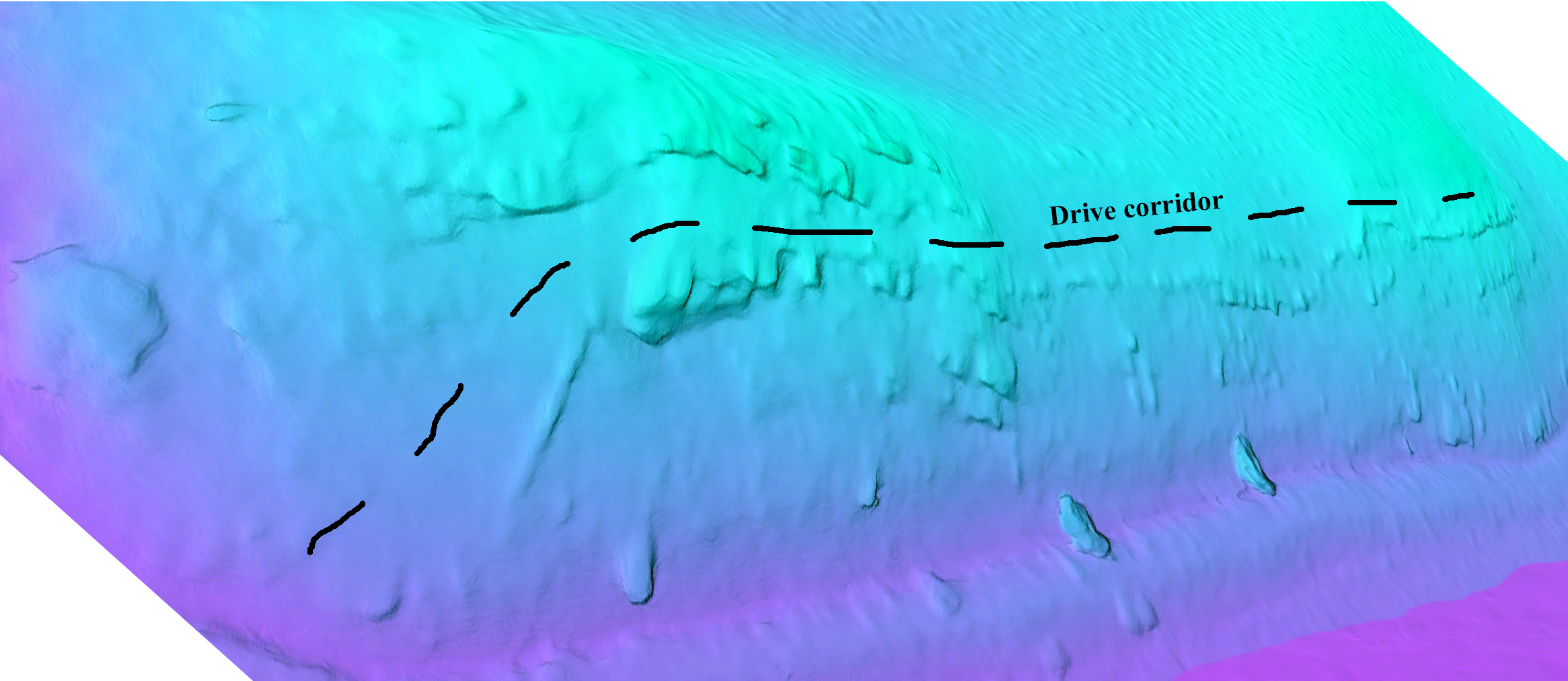 Site 5GN.6940 3D digital surface model of the drive corridor
Site 5GN.6940 3D digital surface model of the drive corridor
Occurrence of Culturally Modified Bison Bone Elements in West-Central and Southwestern Colorado: An Archaeological Assessment for the Western Colorado Bison Project Phase II for History Colorado State Historical Fund Grant No. 2019-MC-009. Prepared by Holly Shelton, Project Archaeologist; Michael Berry, Ph.D., Database Architect; and Carl E. Conner, Principal Investigator.
Abstract: This is a History Colorado State Historical Fund grant (2019-M2-009) related project undertaken by Dominquez Archaeological Research Group for the purpose of conducting data collection and radiometric testing of culturally associated and culturally modified bison faunal elements specific to west-central and southwestern Colorado. The fundamental purpose of this report is to develop a more accurate understanding of the interrelationship of bison and the native occupants of the region and to share this knowledge with the scientific and academic community, the interested public, and with present day Ute peoples and other tribes whose ancestral home and hunting territory included west-central and southwestern Colorado.
Resultant data was assimilated into comprehensive and subject specific databases. In addition to the 250 bison faunal elements identified in Phase I of the Western Colorado Bison Project (Shelton, Berry and Conner 2017) an additional 470 bison specimens were located during investigations conducted for this project (Phase II). Of these, 89 specimens are addressed in the body of the report with 402 specimens representing the Ziegler Reservoir Fossil Site (5PT1264) bison bone assemblage. All available specimens were analyzed and evaluated for cultural modification and other indicators and subsequent data was incorporated into both standard spreadsheets, tables and graphs, and electronic interactive databases and query maps. Radiocarbon dates obtained from culturally modified specimens have been added to Dominquez Archaeological Research Group’s Colorado Radiocarbon Database Project and to the Western Colorado Bison Study website database both of which include query tools, critical information, images, and interactive maps.
The project report, edited for general release, is available here:
Testing and Evaluation of The Bocco Mountain Bison Ceremonial Site (5EA2742), Eagle County, Colorado for the Bureau of Land Management Glenwood Springs Field Office. Prepared by James C. Miller, Dakota N. Smith, Carl. E. Conner, and Barbara Davenport
Abstract: In 2009, in response to a request by the Glenwood Springs Field Office of the Bureau of Land Management (BLM), Dominquez Archaeological Research Group (DARG) conducted testing and evaluation of site 5EA2742, a single encounter bison kill and ceremonial site that is evaluated as eligible for listing on the National Register of Historic Places (NRHP). Limited excavations totaling four square meters were conducted on the site to recover visible elements, but parts of the butchered animal and other cultural remains probably remain buried at the site. The recovered elements—crania, mandible, atlas, partial thoracic-lumbar vertebral column, sacrum, partial pelvis, articulated tarsals, metatarsal fragment, and broken ribs—are the remains of a 4-year old female killed in early winter during the end of Little Ice Age, most likely between AD 1828 and 1840. The carcass was butchered using prehistoric methods in use for over 10,000 years. No stone tools were recovered—prominent cut marks are made by metal tools—however, the articulated tarsal unit was employed as an astragalus-calcaneous-metatarsal chopper. After the kill, the skull with articulated atlas and mandible were mounted on an improvised, upright rock structure facing the sunrise in winter, which strongly suggests a Plains cultural affiliation. The mounting is interpreted as a request for the bison spirit to give life to the sun and world rather than a prayer for the health or renewal of the local bison population.
Analysis of 5ME15338 Bison Remains from Big Dominguez Canyon Mesa County, Colorado for the Bureau of Land Management Grand Junction Field Office, 2017. Prepared by Carl Conner, Principal Investigator, Holly Shelton, Faunal Analysis Specialist, and Masha Conner, Photographer/Graphics Specialist.
Abstract: In response to a request from the Grand Junction Field Office of the Bureau of Land Management (GJFO BLM), Dominquez Archaeological Research Group examined the osteological remains of a bison recovered from 5ME15338 during a 2014 GJFO BLM construction of a fence. The bones consisted of three pieces of a left femur and two pieces of the left side of the os coxae. One of the specimens exhibited possible but not definitive evidence of cultural modification. Radiocarbon analysis of a bone collagen sample produced a conventional age of 40±30 BP with a calibrated ages of AD1700-1730 (20.5%), AD1810-1850 (18.6%), AD1870-1920 (56.3%).
Collection and Analysis of the Little Bull Draw Bison Remains at 5RB8828 Rio Blanco County, Colorado for the Bureau of Land Management White River Field Office Meeker, Colorado. Prepared by Carl Conner, Principal Investigator, Holly Shelton, Project Archaeologist, and Masha Conner, Photographer/Graphics Specialist.
Abstract: In August 2017, research associates of Dominquez Archaeological Research Group collected 31 bison bones and bone fragments from an erosional exposure of alluvium deposits in Little Bull Draw, a tributary of Douglas Creek, Northwest Colorado. The remains were determined to be an adolescent bison of unknown sex. Several of the specimens exhibited possible but not definitive evidence of cultural modification. Radiocarbon analysis of a bone collagen sample produced a conventional age of 1020±30 BP with a calibrated age of AD 910 -1050 (90.6 %).
